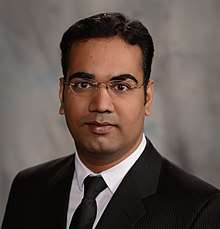Akhilesh K. Gaharwar
Akhilesh K. Gaharwar (born January 3, 1982, Nagpur, India) is an Indian academic and an assistant professor in the Department of Biomedical Engineering at Texas A&M University.[1] The goal of his lab is to understand the cell-nanomaterials interactions and to develop nanoengineered strategies for modulating stem cell behavior for repair and regeneration of damaged tissue.[2][3]
Akhilesh K Gaharwar | |
|---|---|
 | |
| Born | January 03, 1982 |
| Nationality | India |
| Alma mater | Purdue University, Massachusetts Institute of Technology, Harvard University, Indian Institute of Technology, Visvesvaraya National Institute of Technology |
| Known for | Hydrogels, nanotechnology, regenerative medicine, bioprinting. |
| Awards | NIH Director's New Innovator Award |
| Scientific career | |
| Fields | Biomedical Engineering, Materials Science, Nanomaterials, Tissue Engineering, Bioprinting, Hydrogels |
| Institutions | Texas A&M University |
| Academic advisors | Robert S. Langer, Ali Khademhosseini |
| Website | https://gaharwar.engr.tamu.edu/ |
Education and work
Gaharwar completed his postdoctoral training with Robert Langer at Massachusetts Institute of Technology and Ali Khademhosseini at Harvard University. He received his PhD in Biomedical Engineering from Purdue University, Master in Technology (M.Tech.) from Indian Institute of Technology, Bombay and Bachelor of Engineering (B.E) from Visvesvaraya National Institute of Technology.
Gaharwar research experience spans diverse fields, including materials science, chemistry, biology, and engineering of polymeric biomaterials and nanocomposites. He is developing advanced biomimetic nanostructure for functional tissue engineering.[4] His research program integrates nanomaterials and stem cells for the development of functional tissue engineering. He is leveraging principles from biomedical engineering, materials science, bioprinting, microfabrication, chemistry, and stem cell biology in a unique way to address some of the daunting challenges in regenerative medicine.
Gaharwar has published 70 journal articles, two-issued/pending patents, one book chapter, and more than 50 conference presentations and have H-index of 32.[5] He is the editor of biomedical textbook entitled "Nanomaterials in Tissue Engineering: Fabrication and Applications".[6] He is also an editorial board member of “Scientific Reports”.[7] Gaharwar has published extensively in the area of nanomaterials, biomaterials, bioprinting, tissue engineering, and stem cell bioengineering.
Awards
- 2018 Rising Star Award by Cellular & Molecular Bioengineering Special Interest Group of Biomedical Engineering Society (Jan 2018)
- 2018 Langmuir Early Career Authors in Fundamental Colloid and Interface Science (Jan 2018)
- 2017 NIH Director's New Innovator Award (DP2) by National Institute of Health (Oct 2017)
- 2011 Biomedical Engineering Society Graduate Award[8]
References
- "Gaharwar joins Biomedical Engineering". Archived from the original on 2016-06-11. Retrieved 2018-03-19.
- "Texas A&M University – People – Faculty – Gaharwar".
- "Gaharwar Lab- Inspired Nanomaterials and Tissue Engineering (iNanoTE) Laboratory".
- "Gaharwar Lab- Inspired Nanomaterials and Tissue Engineering (iNanoTE) Laboratory".
- "Google Scholar".
- "Texas A&M Prof. Akhilesh Gaharwar Co-edits New Biomedical Textbook".
- "Editorial Advisory Panel and Editorial Board – Nature".
- "Two Weldon Students Take Top National BMES Honors".